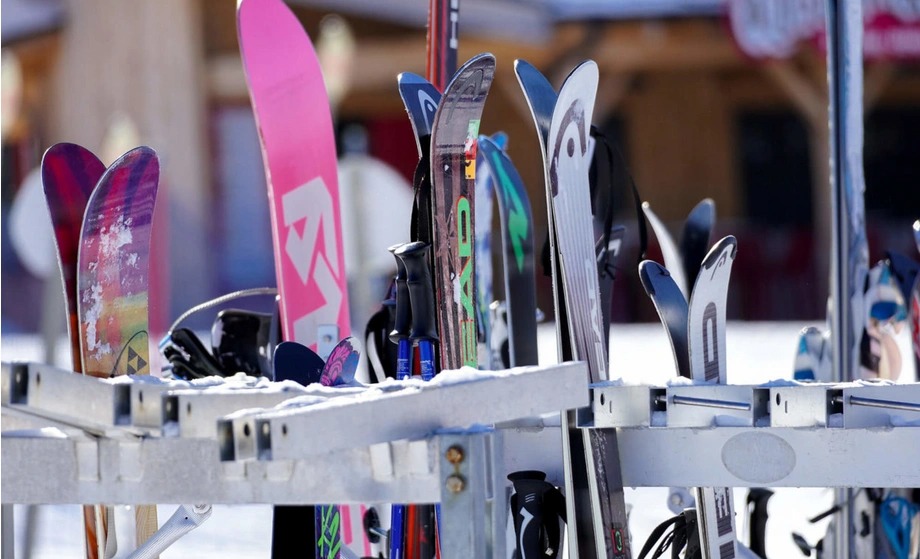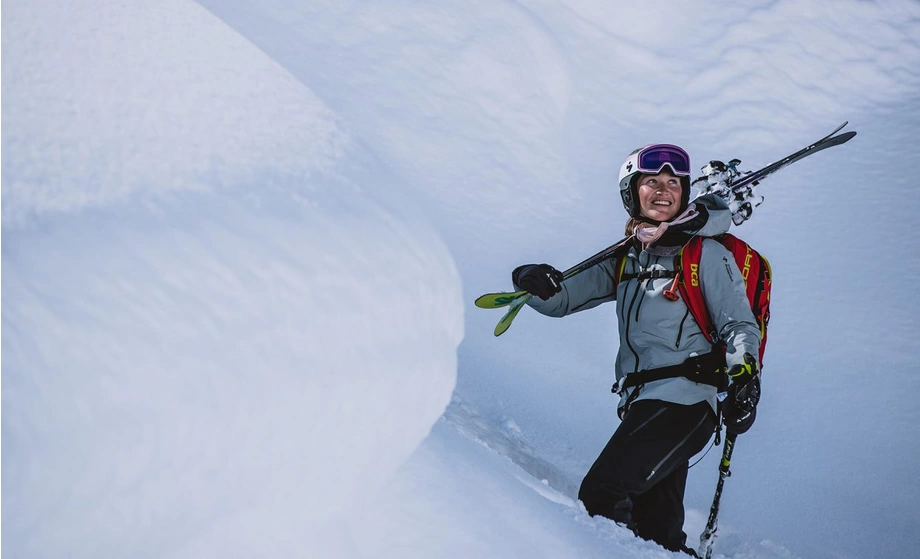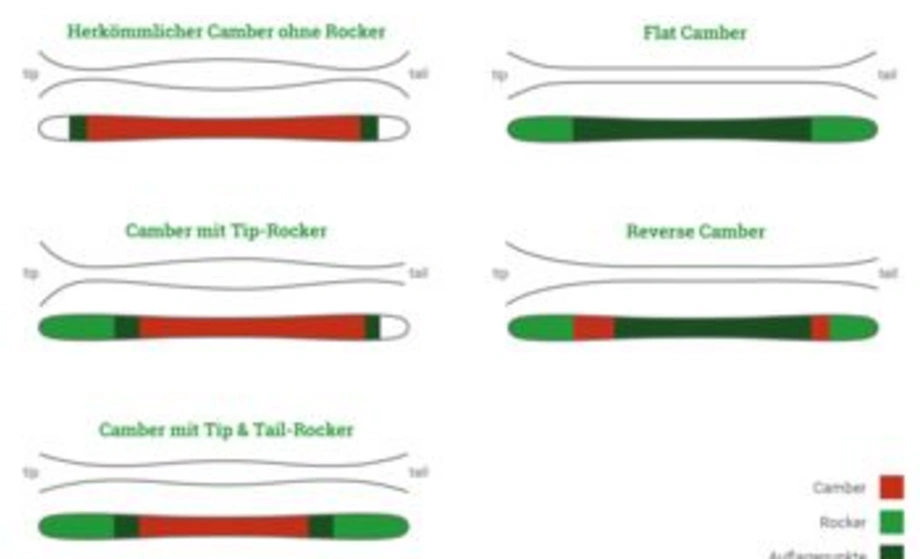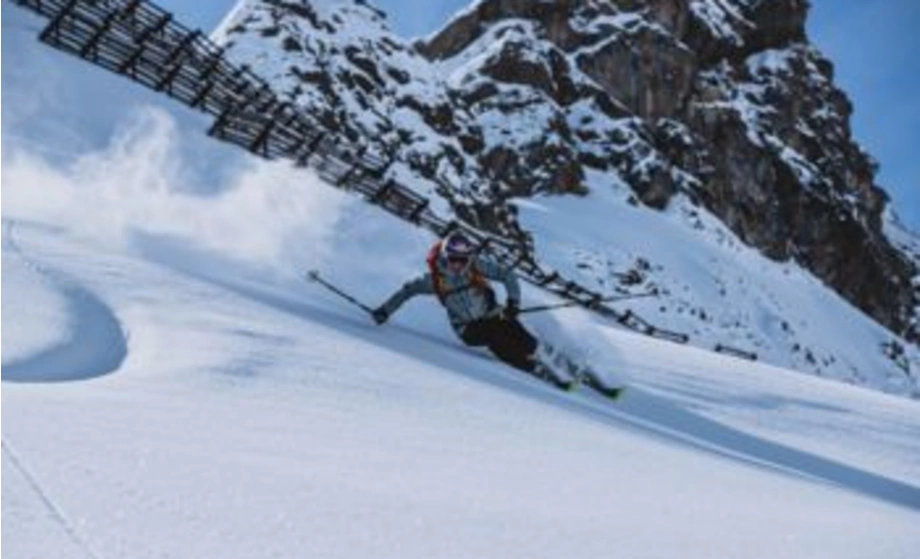The term “rocker” was used to describe individuals who followed a particular lifestyle associated with rock and roll. Nobody would have thought of ski design. But that has changed a lot over the years! Today, the rocker is not only equated with ACDC but also with modern skis. Terms like “tip and tail rocker,” “full rocker,” or “flat” dictate the scene. But what exactly are rocker skis? What was a camber again? And which ski construction suits my style and skill set? Come and get a brief overview below!
Rocker, camber, flex – essential terms in ski construction
Understanding the various rocker technologies is essential to understanding the terminology concerning ski construction. The elements described influence each other in their effect and should be seen as a whole. Many terms ultimately mean the same thing. I will, therefore, limit myself to the most frequently used ones, keeping it short and straightforward.
What are rocker skis?
A rocker is a construction method and the geometric shape of a ski. Ultimately, it is the upward curve of the ski. The rocker is found in the front area of the ski (tip rocker), in the rear area (tail rocker), or even over the entire ski’s length (full rocker).

Rockers can be found in many/most ski models today: From freeride skis to race carvers.
Most manufacturers use this technology, some even for the entire model range. Rocker construction is usually given in freeride skis, freestyle skis, all-mountain skis, touring skis, or race skis. The constant development and modifications of rocker skis have ensured that the design has become advantageous in most scenarios, whether slalom, freeride, or touring.
But, of course, not all rockers are alike. The differences in construction and geometry are immense and substantially impact the skiing characteristics. A rocker on a World Cup slalom ski differs greatly from a freeride ski. For example, a tip rocker can start directly in front of the toe of the ski binding and extend over the entire front part of the ski, or it can just encompass the primary tip. Where the rocker is placed dictates the designer’s preferences and the ideal area of use.
Camber, what is the pretension for skis?
Camber can also be referred to as pretension. A traditional camber causes the ski to lift off the base in the middle while resting on the ground. It is, therefore, the camber of the ski. The highest point is usually below the mounting plate, i.e., below the center of the boot. The pretension is intended to distribute the pressure effectively over the shovel and the end of the ski and alternates from model to model.
Some freeride skis have a negative camber (reverse camber). This means that the ski rests on the ground in a concise area below the middle of the boot, bending upwards towards the ski’s end and tip.
Last but not least, there are also skis without any camber (flat camber). These skis lie flat under the foot in a larger area and only curve upwards further in the front and back.

Not only freeride skis are equipped with a rocker, but also carving skis, like the K2 Disruption here, are increasingly coming with a tip rocker for more turning pleasure.
What is the effective edge length?
The steel edge of a ski usually runs the shovel to the end of the ski. Due to the ski’s construction, not the entire edge grips the snow during a turn, but only a specific part, the so-called effective edge length. In addition to the construction, this depends on the load and the resulting deflection of the ski and is, therefore, continually variable. The deflection of the ski under load is referred to as flexure throughout the ski community.
The bending line, and thus also the effective edge length, severely influences the ski’s steering behavior. If the effective edge length is long, the ski runs smoother and has more edge grip at high speeds. On the other hand, a shorter edge length makes the ski less maneuverable.
What is the flex of a ski?
The ski’s flex describes the hardness in terms of the overall bending behavior along the longitudinal axis of the ski, i.e., upwards and downwards. It is not to be confused with torsion. This refers to the twisting of the transverse axis. The flex affects the edge grip, the deflection of the waisted ski, and the radius.
A ski with a soft flex can be bent more quickly and thus reduce the radius more easily than a stiff flex and waist. On the other hand, a stiff flex provides more edge grip on hard surfaces than a soft flex under the same load.
Note: Flex can also vary throughout a ski. For example, a ski can be softer in the shoveled area and stiffer in the tail.
Different ski constructions: Which rocker suits me best?
But which ski suits me now, and which construction should I choose if I prefer skiing in deep snow or ice and hard pack?

An overview of the different ski construction methods.
1. Conventional camber without rocker
This construction is the so-called traditional ski shape, also referred to as a full-camber or classic-camber. The ski has a continuous conventional camber from the tip to the tail.
- Riding characteristics: The effective edge length and running smoothness are already great when skiing straight ahead and in low cornering positions. The ski is easy to steer and convinces with a high-edge grip. The lift of the ski is minimal.
- Area of use: It is primarily used on the piste and in hard to icy snow. It is also found on some race-touring skis.
2. Tip-Rocker
The tip rocker is the most common today. Here, the ski has a conventional preload under the binding and a rocker construction on the ski’s tip.
- Riding characteristics: The effective edge length is shortened here. The ski is, therefore, more maneuverable and easier to turn. Thus, the ski is also forgiving of mistakes. The rocker provides more lift in soft snow. Meanwhile, the pretension throughout the middle supports good edging.
- Area of use: This construction is especially useful for all-around skis. However, some manufacturers already use it across the entire product range, and it can, therefore, be found in all ski categories. Even many race skis have been fitted with a tip rocker.
3. Tip- and Tail-Rocker
In addition to the tip rocker, tip and tail rockers are also widely used. Under the binding, the ski comes with a traditional camber and has a rocker built into the shovel and the tail of the skis.
- Riding characteristics: The effective edge length is shorter here and more maneuverable. It forgives mistakes more quickly than a full camber but doesn’t like hard and icy slopes too much. The traditional preload under the binding can still be ridden with reasonable edge control.
- Area of use: Mainly found in all-around skis, free touring, and freeride skis.
4. Full-Rocker
Here, the pretension, i.e., the ski’s camber, is pronounced in exactly the opposite direction. This means that the ski only rests on the ground under the middle of the boot and curves upwards towards the ends of the ski. This type of construction is often referred to as negative camber.
- Edge length: The edge length under the binding is minimal but still variable. This makes it easier to overcome the inertia of wide skis. A harmonic bending line can increase the edge length. Excellent lift in deep snow, a bit like a water ski.
- Area of use: Especially for soft and deep snow and big mountain lines in the backcountry.
How long does a rocker ski need to be?
The chosen ski length for rocker skis also strongly depends on the desired area of use and, thus, on the type of ski. For example, an agile and narrow slalom carver should be somewhere between 155 and 170 centimeters, while a thick freeride ski can be up to 200 centimeters long. Of course, the length of the ski also depends on your height/weight. As described above, the rocker’s size also affects the ski’s turning ability. Thus, a 200-centimetre-long ski with a long rocker can still be agile.

The length of the ski depends mainly on the area of use and the size of the skier – freeride skis, for example, tend to be longer.
The development of the rocker
Although the rocker has only made a complete breakthrough in ski construction in recent years, it has been around for many years—since the first skis were made. Today, the shape is known as traditional geometry, with a so-called traditional camber coming later.
If you look at the first rocker skis (for example, the first K2 Pontoon), you can see that the rocker was very pronounced at the tip. This positively affected the lift, but such a ski was also very slow in deep snow. The reason was the considerable snow resistance resulting from the upward bend. Thus, the first rocker skis could not create an optimal bending line. The rocker area fluttered rather unsteadily in the air, and the effective edge length was minimal even when loaded.
Finally, among others, Dynastar brought a ski onto the market. The rocker in the shoveled area did not protrude quite as far upwards, and the flex in this area was kept stiff, automatically leading to a smoother ski ride.
K2, in particular, was very innovative regarding rocker technology and developed the Side Seth, a ski whose rocker was very long (it started directly in front of the binding) but which, thanks to its construction, had a very harmonious flex. The entire rocker area could be edged under load, increasing the effective edge length and making the ski much smoother on hardpack. With the Hoji, for example, 4FRNT has succeeded in developing a ski that coped with the hard pack despite its negative pretension – made possible because of the thought-out flexure and the fact that the ski works almost over its entire length.
These are just a few examples that illustrate rocker technology’s development and optimization. Nowadays, almost all ski manufacturers have designed skis with rockers to cope with any terrain. With all the differences, the most important thing is that the ski works harmoniously over its entire length, achieving an optimal flex.
Conclusion
Rocker technology has completely caught on. Nowadays, most skis perform in any terrain. But there is certainly no single ski that is optimal in every situation. And it is precisely for this reason that different construction methods are chosen for particular types of skiing.